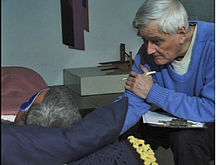Hypnoanalysis
Hypnoanalysis is the technique of using hypnosis in the practice of psychoanalysis and psychotherapy.[1] It attempts to utilize the trance state induced by hypnosis to effect a conscious understanding of a person's unconscious psychodynamics.[2]

History
Hypnoanalysis is derived from the prefix hypno, which the French Étienne Félix d'Henin de Cuvillers first used to describe the hypnotic state.[3] The term hypnoanalysis was coined by James Arthur Hadfield, who claimed that he invented the term to describe the use of hypnosis to retrieve memories, particularly among patients who are suffering from amnesia.[4] Other authors who contributed to its development include psychoanalyst Lewis Wolberg and German psychologist Erika Fromm.[5] Fromm is particularly noted for her collaboration with Daniel Brown and Michael Nash, which produced their works detailing the benefits of hypnoanalysis in the 1980s and 1990s.[6]
Use
Hypnoanalysis is often used with the intention of uncovering repressed memories in therapy patients. It can be used for direct recall or in more indirect ways that involve other therapeutic approaches such as drawing and free writing.[7] A technique used in hypnoanalysis called the "affect bridge" differs from treatment during regular psychoanalysis. Whereas psychoanalysis may use similar ideas to connect older events, an affect bridge helps the client remember an older memory by recalling other memories that have the same associated emotion.[8] Some patients have reported that when they regress to a memory from much earlier in life, that they feel their body returns to its correct chronological age. This can cause them to feel young and small.[9]
References
- Wolberg, Lewis (1946). Hypnoanalysis. London, United Kingdom: Heinemann. ISBN 9781483195469.
- Zindel, J. Philip (14 October 2015). "Hypnoanalyse [Hypnoanalysis]". In Revenstorf, Dirk; Peter, Burkhard (eds.). Hypnose in Psychotherapie, Psychosomatik und Medizin [Hypnosis in Psychotherapy, Psychosomatic Medicine, and Medicine] (in German). Berlin/Heidelberg, Germany: Springer. pp. 297–304. doi:10.1007/978-3-642-54577-1_24. ISBN 978-3-642-54576-4.
- Campbell, Robert Jean; M.D, Director Gracie Square Hospital and Clinical Professor of Psychiatry Robert Jean Campbell (2004). Campbell's Psychiatric Dictionary, Eight Edition. New York: Oxford University Press, USA. p. 317. ISBN 0-19-515221-2.
- Wolberg, Lewis R. (2013). Medical Hypnosis - Volume I - The Principles of Hypnotherapy. Read Books Ltd. ISBN 978-1-4733-9173-4.
- Araoz, Daniel L. (2012). Integrating Hypnosis with Psychotherapy: The Legacy of Buddhism and Neuroscience. Jefferson, NC: McFarland. p. 11. ISBN 978-0-7864-9071-4.
- Araoz, Daniel L. (2012). Integrating Hypnosis with Psychotherapy: The Legacy of Buddhism and Neuroscience. McFarland. p. 11. ISBN 9780786490714.
- Wolberg, Lewis R. (2013-10-02). Hypnoanalysis. Butterworth-Heinemann. ISBN 978-1-4831-9546-9.
- Watkins, John G. (1971-01-01). "The affect bridge: A hypnoanalytic technique". International Journal of Clinical and Experimental Hypnosis. 19 (1): 21–27. doi:10.1080/00207147108407148. ISSN 0020-7144. PMID 5100851.
- M.D, Edith Klemperer (1954-04-01). "Changes of the body image in hypnoanalysis". Journal of Clinical and Experimental Hypnosis. 2 (2): 157–162. doi:10.1080/00207145408409948. ISSN 0095-988X.